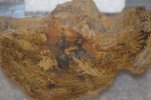Matteo
Well-Known Member
- Joined
- Aug 8, 2012
- Messages
- 1,314
*see what I did there?
After massive demand** over on the Photo Challenge thread, I've decided to start a fossil thread. A place where members can post photos of fossils that they have found - so nothing purchased from dealers, or received as gifts. A place where members can post photos of fossils, ask questions, and discuss issues surrounding the finds. Try to give as much detail as possible: location, type of rock, species, name, age, etc.
I've been interested in geology since I was a child. And not just dinosaurs, but actual geology; the rocks, formations, fossils, etc. But it was fossils that really got me going - the idea that I could find something that was millions of years old and be the only person to ever see it. Whenever I was on a beach, I always had my eyes downward - and was lucky to have grandparents who would take me to various beaches in South Wales on the weekend where fossils could be found. I took Geology at O and A Level went on to do a degree (though in "industrial geology") and would have loved to continue it professionally - but that was not to be.
In the 80's (in my teens) and the 90's I hunted around South and West Wales and had a few trips to South West England, but since moving to Belgium at the very end of the 90's have not continued - though my interest has not waned.
So, the start with, here a a few of favourite animals...trilobites. The first three were posted already on another thread (extinct animals you wish were still alive) but I've added a few others I found after a hunt in the attic this weekend.
These were found near Builth Wells in the mid/late 80s. Most likely Ogyginus Cordensis (the large one has been identified as such), Ordovician in age (485-445mya). I don't remember if they were found "as is" or after I split open a rock, except for the largest which I distinctly remember doing so.







And lastly, this one from a disused quarry in nearby Llandrindod Wells. Again Ordovician and I think Ogygiocarus buchi. When I was there specimens were easy to find but unfortuntely in very fragmented rock - I didn't find a complete one - just lots of cephalums (heads) and pygidiums (tails). I thought I had a lot more of these but I think I got rid of most when I moved over here. This was the only one could find:

**well... @Mouse and @THX1138
After massive demand** over on the Photo Challenge thread, I've decided to start a fossil thread. A place where members can post photos of fossils that they have found - so nothing purchased from dealers, or received as gifts. A place where members can post photos of fossils, ask questions, and discuss issues surrounding the finds. Try to give as much detail as possible: location, type of rock, species, name, age, etc.
I've been interested in geology since I was a child. And not just dinosaurs, but actual geology; the rocks, formations, fossils, etc. But it was fossils that really got me going - the idea that I could find something that was millions of years old and be the only person to ever see it. Whenever I was on a beach, I always had my eyes downward - and was lucky to have grandparents who would take me to various beaches in South Wales on the weekend where fossils could be found. I took Geology at O and A Level went on to do a degree (though in "industrial geology") and would have loved to continue it professionally - but that was not to be.
In the 80's (in my teens) and the 90's I hunted around South and West Wales and had a few trips to South West England, but since moving to Belgium at the very end of the 90's have not continued - though my interest has not waned.
So, the start with, here a a few of favourite animals...trilobites. The first three were posted already on another thread (extinct animals you wish were still alive) but I've added a few others I found after a hunt in the attic this weekend.
These were found near Builth Wells in the mid/late 80s. Most likely Ogyginus Cordensis (the large one has been identified as such), Ordovician in age (485-445mya). I don't remember if they were found "as is" or after I split open a rock, except for the largest which I distinctly remember doing so.
And lastly, this one from a disused quarry in nearby Llandrindod Wells. Again Ordovician and I think Ogygiocarus buchi. When I was there specimens were easy to find but unfortuntely in very fragmented rock - I didn't find a complete one - just lots of cephalums (heads) and pygidiums (tails). I thought I had a lot more of these but I think I got rid of most when I moved over here. This was the only one could find:
**well... @Mouse and @THX1138



